Russia Diabetes Care Devices Market Size
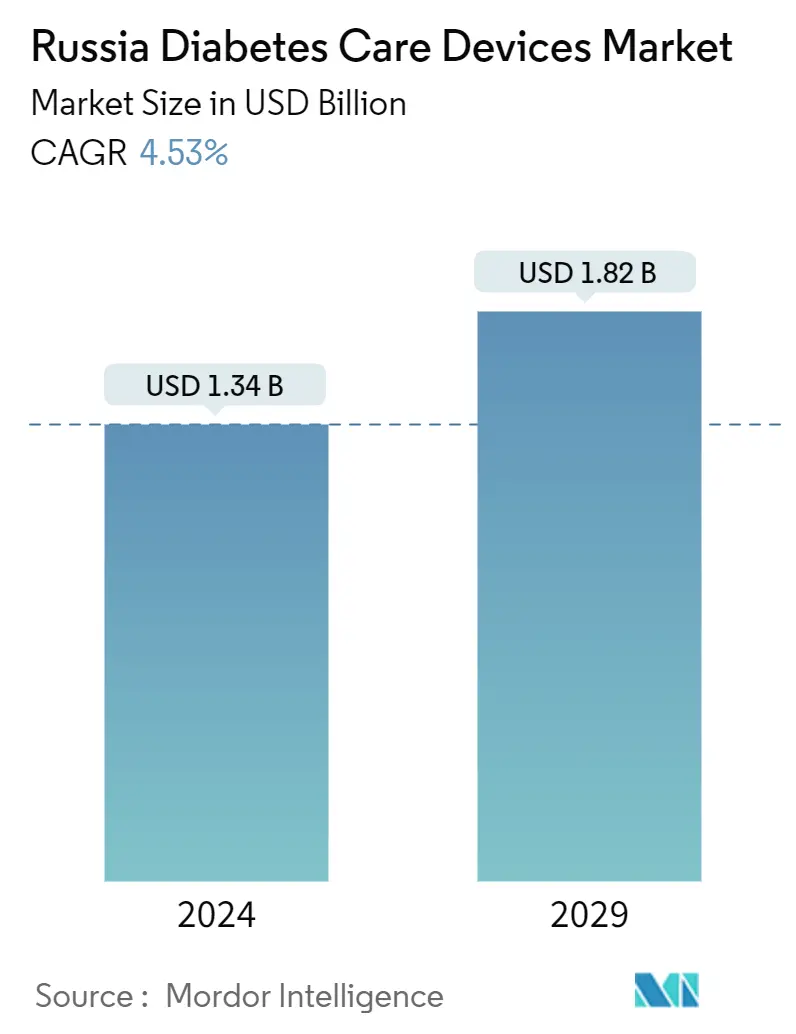
| Study Period | 2019- 2029 |
| Base Year For Estimation | 2023 |
| Forecast Data Period | 2024 - 2029 |
| Market Size (2024) | USD 1.34 Billion |
| Market Size (2029) | USD 1.82 Billion |
| CAGR (2024 - 2029) | 4.53 % |
Major Players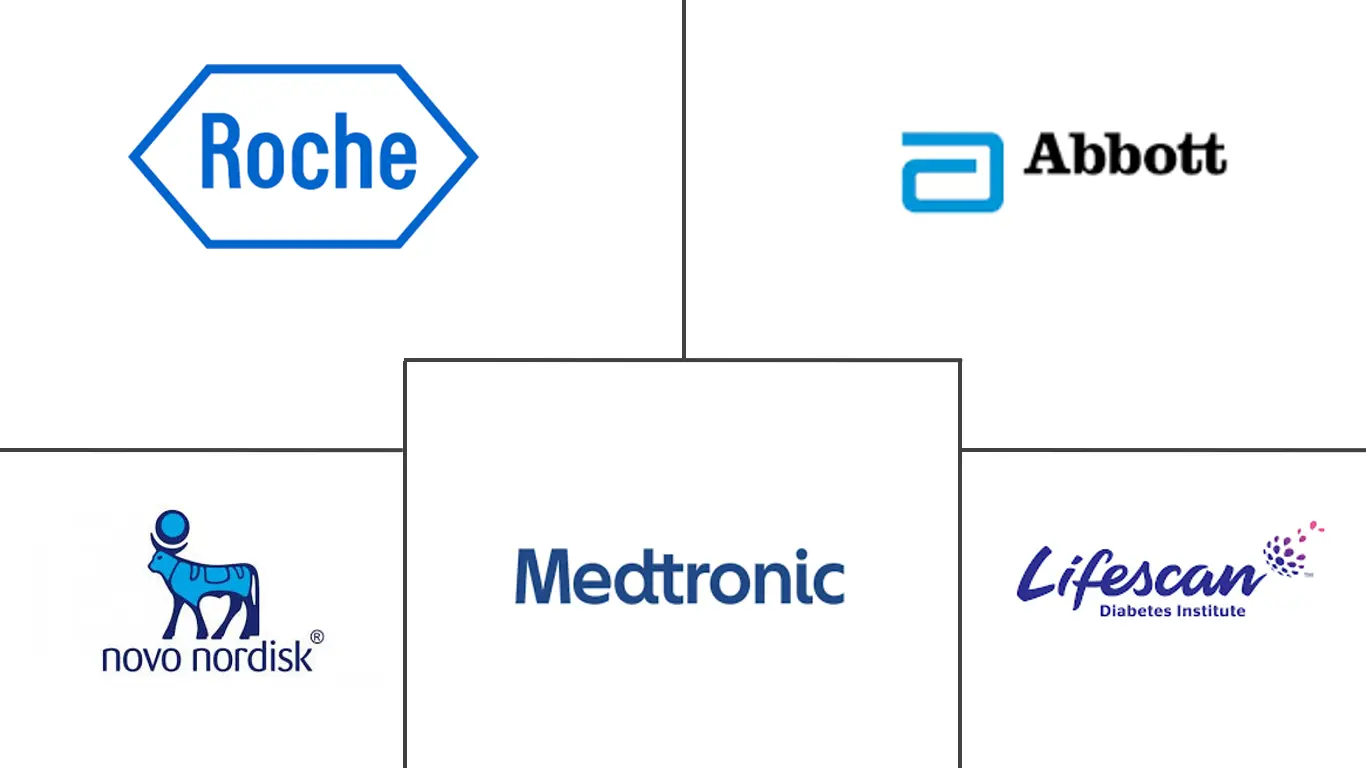
*Disclaimer: Major Players sorted in no particular order |
Russia Diabetes Care Devices Market Analysis
The Russia Diabetes Care Devices Market size is estimated at USD 1.34 billion in 2024, and is expected to reach USD 1.82 billion by 2029, growing at a CAGR of 4.53% during the forecast period (2024-2029).
Within the first year since its inception, the COVID-19 pandemic has been responsible for premature deaths, particularly among older individuals. Russia has the ninth-highest number of confirmed cases in the world affected by COVID-19. Most people who have died of COVID-19 were affected by the co-occurrence of two or more chronic conditions in the same individual. Several studies have confirmed that chronic diseases like diabetes are associated with adverse outcomes in COVID-19 patients.
The COVID-19 pandemic has significantly impacted Russia's diabetes care devices. The pandemic highlighted opportunities for continuing and expanding innovations in the delivery of diabetes care, through virtual consultations between healthcare providers and people with diabetes, and the use of diabetes technology. Crisis management has created unprecedented interest in remote care from both patients and providers and removed many long-standing regulatory barriers. Thus, the COVID-19 outbreak increased the diabetes care device market's growth.
According to Roscongress, Russia ranks fifth in the world in terms of the number of patients with diabetes mellitus in the age range of 20 to 79. In addition, during COVID-19, the mortality rate among patients with diabetes increased by 22%. The rate of newly diagnosed Type 1 and Type 2 diabetes cases is seen to increase, mainly due to obesity, unhealthy diet, and physical inactivity. The rapidly increasing incidence and prevalence of diabetic patients and healthcare expenditure are indications of the increasing usage of diabetic care products.
In May 2021, the World Health Assembly agreed on a Resolution on strengthening the prevention and control of diabetes. It recommends action in areas including increasing access to insulin; promoting convergence and harmonization of regulatory requirements for insulin and other medicines and health products for the treatment of diabetes; and assessing the feasibility and potential value of establishing a web-based tool to share information relevant to the transparency of markets for diabetes medicines and health products.
Therefore, owing to the aforementioned factors the studied market is anticipated to witness growth over the analysis period.
Russia Diabetes Care Devices Market Trends
Continuous glucose monitoring segment is expected to witness a healthy growth rate over the forecast period
The continuous Glucose Monitoring Segment is expected to grow with a CAGR of around 15.05% over the forecast period.
Continuous Glucose Monitoring Devices are automated glucose monitoring systems that consist of a small device that can be worn on the body and held on by an adhesive patch. The sensor part of the device includes a cannula inserted into the top layer of skin and uses interstitial fluid samples to check glucose levels. Sensors are connected to a transmitter that can send data wirelessly to a dedicated mobile receiving device or smartphone. Using CGMs for people with diabetes and their caregivers and communities is beneficial for managing their blood glucose and insulin levels to maintain their health outcomes. CGM makes it significantly easier to manage blood glucose levels by decreasing interruptions and allowing for better sleep. It also improves the mental health of patients or caregivers by reducing the overall mental load of managing diabetes.
Continuous glucose monitoring became a popular alternative to the portable finger-prick glucometers available in the market for the convenience of diabetic patients. Sensors are the most important part of continuous glucose monitoring devices. Various promising glucose-sensing technologies, from traditional electrochemical-based glucose sensors to novel optical and other electrical glucose sensors, are developed, positively impacting the market growth. The continuous glucose monitoring sensors opened new scenarios to assess, off-line, the effectiveness of individual patient therapeutic plans and stimulated the development of innovative online applications. It includes hypo/hyperglycemia alert systems and artificial pancreas closed-loop control algorithms. Continuous glucose monitoring devices are becoming cheaper with the advent of new technologies.
According to IDF, to reduce the diabetes epidemic in the country, the Russian government needs to fully implement a National Diabetes Plan that establishes a state budget to guarantee diabetes care to all Russian citizens. Russia is working towards improving the reimbursement system for all aspects of diabetes care, limiting out-of-pocket payments, and preventing households from incurring catastrophic expenditures. Also, implementing a national screening program to improve the early identification of disturbed carbohydrate metabolism and creating a specialized diabetes health service under the Ministry of Health of the Russian Federation.
The increasing diabetes prevalence and the above factors will likely drive the segment growth over the forecast period.
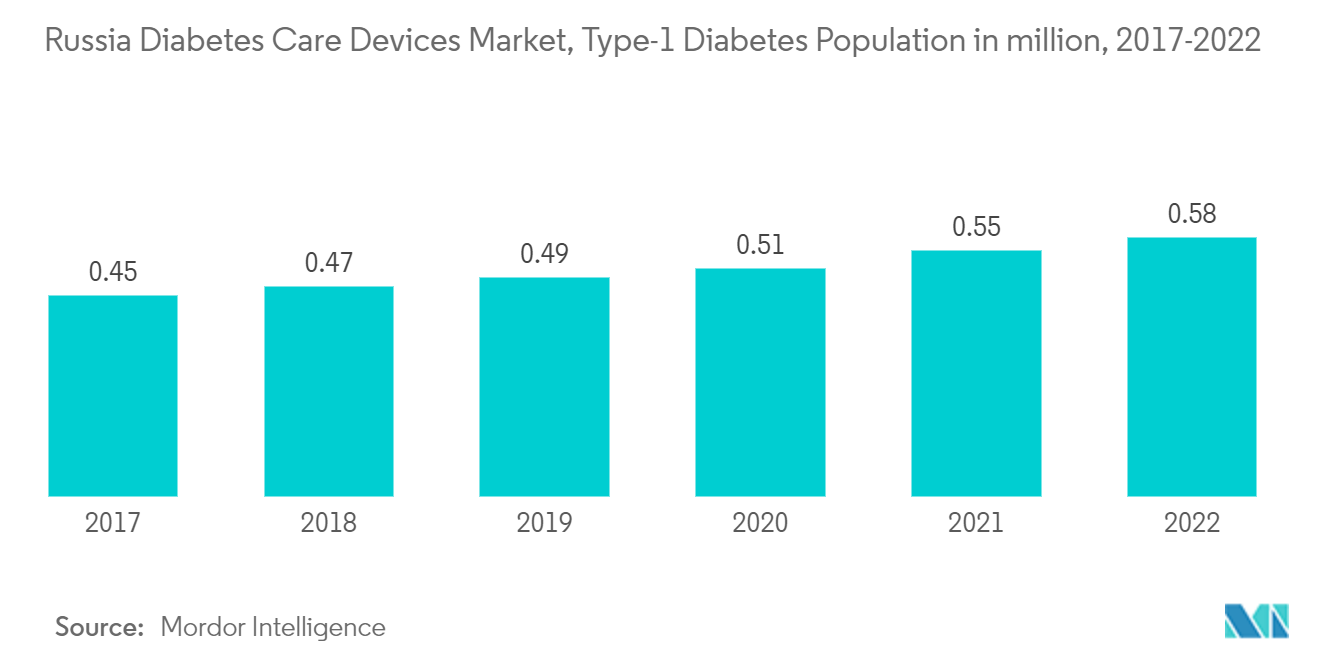
Insulin cartridges in reusable pens hold the highest share in the management devices segment in the current year
Insulin cartridges in reusable pens hold the highest market share of about 35.2% in the management devices segment in the current year.
Insulin cartridges in reusable pens are an upgraded version of insulin vials. Most types of insulins are manufactured in the form of cartridges, making them easily accessible. These devices include all the functional benefits of reusable pens and are cost-effective, as these cartridges are less expensive compared to disposable insulin pens in the long run. Due to the increasing demand for insulin cartridges, most insulin device manufacturers produced reusable insulin pens compatible with various insulin manufacturers' cartridges. These insulin cartridges are considered more consumer-friendly, as they are smaller and less noticeable than the classic vial-and-syringe. These devices are also more portable for consumers on the go. Open cartridges do not need to be refrigerated, making storage easy for consumers. Thus, cartridges are the most cost-effective insulin use, as reusable pens are a one-time investment, unlike disposable pens.
Russia's Federal Targeted Program on Diabetes states that diagnosing diabetes and treating its complications earlier can result in significant savings. Various initiatives are launched to control diabetes in the country. For instance, in Moscow Urban Forum 2021, a Letter of Intent was signed between the Youth Council under the Moscow Department of Health, Moscow Urban Forum, Moscow Diabetic Association, Moscow Diabetic Association Medical Section, KB Strelka, and Novo Nordisk. It is to implement the Cities Changing Diabetes program in Moscow. The program in Moscow is aimed at a comprehensive assessment of the features of diabetes challenges that are relevant for Moscow and the development of an action plan to combat this disease among the most vulnerable groups of the population.
Several technological innovations were developed for years, leading to new types of device creation. These are much less cumbersome and more comfortable for patients than traditional ones. Such advantages helped the rise in the adoption of these products in the Russian market.
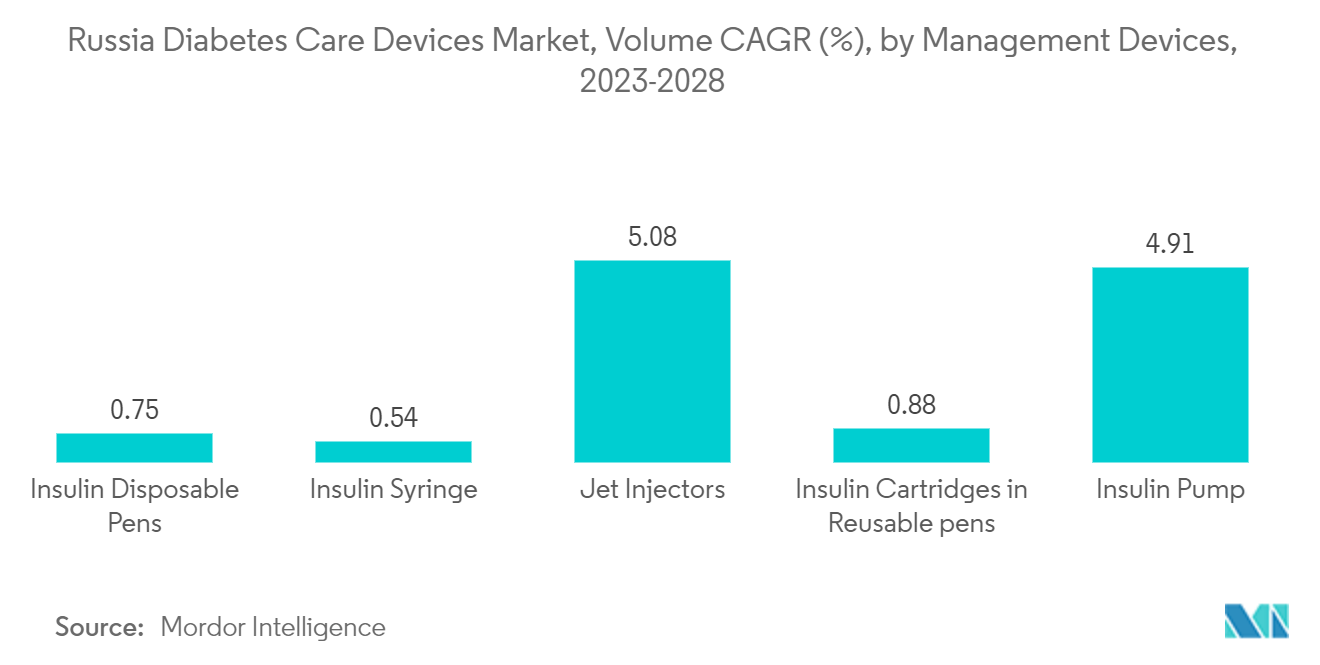
Russia Diabetes Care Devices Industry Overview
The Russian diabetes care devices market is semi-consolidated, with few significant and generic players. Manufacturers drove constant innovations to compete in the market. The major players, such as Abbott, Novo Nordisk, and Medtronic, underwent many mergers, acquisitions, and partnerships to establish market dominance while adhering to organic growth strategies. It is evident from the R&D spending of these companies.
Russia Diabetes Care Devices Market Leaders
-
Abbott Diabetes Care
-
Medtronic PLC
-
Novo Nordisk A/S
-
Roche Diabetes Care
-
Lifescan Inc.
*Disclaimer: Major Players sorted in no particular order
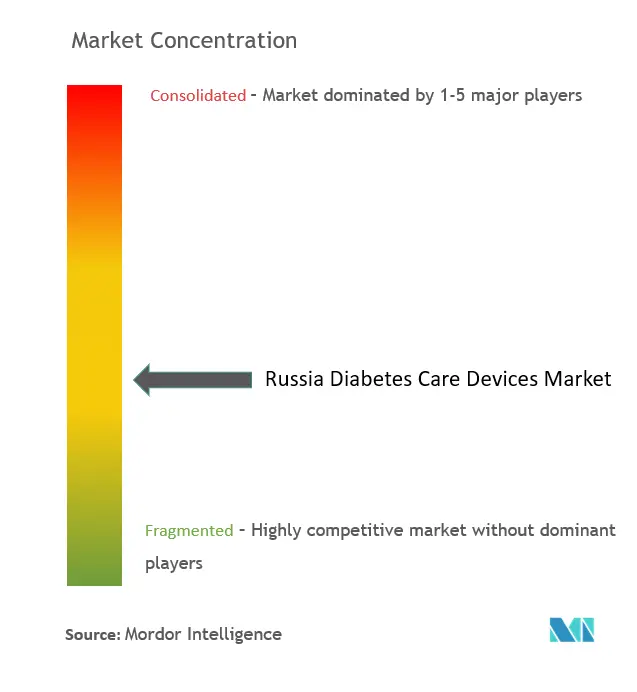
Russia Diabetes Care Devices Market News
- February 2023: Medtronic PLC announced one-year data from the ADAPT study, the first multi-national randomized controlled study comparing the MiniMed 780G advanced hybrid closed loop system (AHCL) performance against multiple daily injections of insulin with an intermittently scanned CGM. The study was done in adults (18 years of age and older) not meeting glycemic targets. At one-year, significant improvements were reproduced in this cross-over group and sustained in those that started on AHCL therapy at the start of the trial.
- April 2022: CamDiab and Ypsomed announced the partnership to develop and commercialize an integrated automated insulin delivery system to help lessen the burden of diabetes management for people with diabetes in European countries. The new integrated AID system is designed to connect Abbott's FreeStyle Libre 3 sensor, the world's smallest and most accurate continuous glucose monitoring sensor, to CamDiab's CamAPS FX mobile app. It connects with Ypsomed's mylife YpsoPump creating a smart, automated process to deliver insulin based on real-time glucose data.
Russia Diabetes Care Devices Market Report - Table of Contents
1. INTRODUCTION
- 1.1 Study Assumptions and Market Definition
- 1.2 Scope of the Study
2. RESEARCH METHODOLOGY
3. EXECUTIVE SUMMARY
4. MARKET DYNAMICS
- 4.1 Market Overview
- 4.2 Market Drivers
- 4.3 Market Restraints
-
4.4 Porter's Five Forces Analysis
- 4.4.1 Bargaining Power of Suppliers
- 4.4.2 Bargaining Power of Consumers
- 4.4.3 Threat of New Entrants
- 4.4.4 Threat of Substitute Products and Services
- 4.4.5 Intensity of Competitive Rivalry
5. MARKET SEGMENTATION
-
5.1 Monitoring Devices
- 5.1.1 Self-monitoring Blood Glucose Devices
- 5.1.1.1 Glucometer Devices
- 5.1.1.2 Blood Glucose Test Strips
- 5.1.1.3 Lancets
- 5.1.2 Continuous Glucose Monitoring
- 5.1.2.1 Sensors
- 5.1.2.2 Durables
-
5.2 Management Devices
- 5.2.1 Insulin Pump
- 5.2.1.1 Insulin Pump Device
- 5.2.1.2 Insulin Pump Reservoir
- 5.2.1.3 Infusion Set
- 5.2.2 Insulin Syringes
- 5.2.3 Cartridges in Reusable pens
- 5.2.4 Insulin Disposable Pens
- 5.2.5 Jet Injectors
-
5.3 Distribution Channel
- 5.3.1 Online
- 5.3.2 Offline
6. MARKET INDICATORS
- 6.1 Type-1 Diabetes Population
- 6.2 Type-2 Diabetes Population
7. COMPETITIVE LANDSCAPE
-
7.1 Company Profiles
- 7.1.1 Abbott Diabetes Care
- 7.1.2 Roche
- 7.1.3 Lifescan
- 7.1.4 Medtronic
- 7.1.5 Arkray Inc.
- 7.1.6 Ascensia Diabetes Care
- 7.1.7 Novo Nordisk A/S
- 7.1.8 Eli Lilly
- 7.1.9 Insulet Corporation
- 7.1.10 Sanofi
- 7.1.11 Rossmax International Ltd
- *List Not Exhaustive
-
7.2 Company Share Analysis
- 7.2.1 Self-monitoring Blood Glucose Devices
- 7.2.1.1 Abbott Diabetes Care
- 7.2.1.2 LifeScan
- 7.2.1.3 Others
- 7.2.2 Continuous Glucose Monitoring Devices
- 7.2.2.1 Abbott Diabetes Care
- 7.2.2.2 Medtronic PLC
- 7.2.2.3 Others
- 7.2.3 Insulin Devices
- 7.2.3.1 Insulet Corporation
- 7.2.3.2 Novo Nordisk A/S
- 7.2.3.3 Others
8. MARKET OPPORTUNITIES AND FUTURE TRENDS
** Subject To AvailablityRussia Diabetes Care Devices Industry Segmentation
Diabetes care devices are the hardware, equipment, and software used by diabetes patients to regulate blood glucose levels, prevent diabetes complications, lessen the burden of diabetes, and enhance the quality of life. The Russia Diabetes Care Devices Market is segmented into monitoring devices (self-monitoring blood glucose devices (glucometer devices, blood glucose test strips, and lancets), continuous glucose monitoring devices (sensors and durables)), management devices (insulin pumps (insulin pump devices, insulin pump reservoir, and infusion set), insulin syringes, cartridges in reusable pens, disposable pens, and jet injectors). The report offers the value (in USD) and volume (in units) for the above segments.
| Monitoring Devices | Self-monitoring Blood Glucose Devices | Glucometer Devices |
| Blood Glucose Test Strips | ||
| Lancets | ||
| Monitoring Devices | Continuous Glucose Monitoring | Sensors |
| Durables | ||
| Management Devices | Insulin Pump | Insulin Pump Device |
| Insulin Pump Reservoir | ||
| Infusion Set | ||
| Management Devices | Insulin Syringes | |
| Cartridges in Reusable pens | ||
| Insulin Disposable Pens | ||
| Jet Injectors | ||
| Distribution Channel | Online | |
| Offline |
Russia Diabetes Care Devices Market Research FAQs
How big is the Russia Diabetes Care Devices Market?
The Russia Diabetes Care Devices Market size is expected to reach USD 1.34 billion in 2024 and grow at a CAGR of 4.53% to reach USD 1.82 billion by 2029.
What is the current Russia Diabetes Care Devices Market size?
In 2024, the Russia Diabetes Care Devices Market size is expected to reach USD 1.34 billion.
Who are the key players in Russia Diabetes Care Devices Market?
Abbott Diabetes Care, Medtronic PLC, Novo Nordisk A/S, Roche Diabetes Care and Lifescan Inc. are the major companies operating in the Russia Diabetes Care Devices Market.
What years does this Russia Diabetes Care Devices Market cover, and what was the market size in 2023?
In 2023, the Russia Diabetes Care Devices Market size was estimated at USD 1.28 billion. The report covers the Russia Diabetes Care Devices Market historical market size for years: 2019, 2020, 2021, 2022 and 2023. The report also forecasts the Russia Diabetes Care Devices Market size for years: 2024, 2025, 2026, 2027, 2028 and 2029.
Russia Diabetes Care Devices Industry Report
Statistics for the 2024 Russia Diabetes Care Devices market share, size and revenue growth rate, created by Mordor Intelligence™ Industry Reports. Russia Diabetes Care Devices analysis includes a market forecast outlook 2029 and historical overview. Get a sample of this industry analysis as a free report PDF download.



